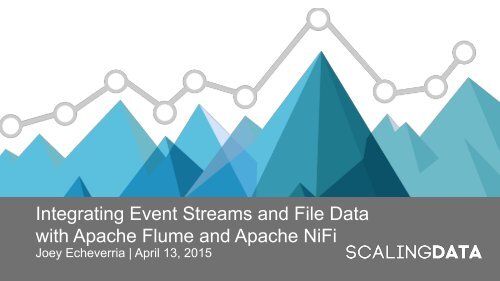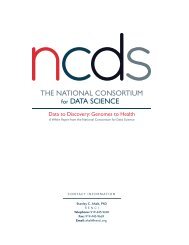Integrating Event Streams and File Data with Apache Flume and Apache NiFi
Integrating Event Streams and File Data
Integrating Event Streams and File Data
Create successful ePaper yourself
Turn your PDF publications into a flip-book with our unique Google optimized e-Paper software.
<strong>Integrating</strong> <strong>Event</strong> <strong>Streams</strong> <strong>and</strong> <strong>File</strong> <strong>Data</strong><br />
<strong>with</strong> <strong>Apache</strong> <strong>Flume</strong> <strong>and</strong> <strong>Apache</strong> <strong>NiFi</strong><br />
Joey Echeverria | April 13, 2015
<strong>Data</strong> integration
<strong>Data</strong> integration<br />
• Multiple data source
<strong>Data</strong> integration<br />
• Multiple data source<br />
• Questions
Challenges
Challenges<br />
• Unique sources
Challenges<br />
• Unique sources<br />
– Format
Challenges<br />
• Unique sources<br />
– Format<br />
– Schema
Challenges<br />
• Unique sources<br />
– Format<br />
– Schema<br />
– Protocol
Challenges<br />
• Unique sources<br />
– Format<br />
– Schema<br />
– Protocol<br />
– Batchiness
Challenges<br />
• Unique sources<br />
– Format<br />
– Schema<br />
– Protocol<br />
– Batchiness<br />
• Big data
Traditional (Hadoop) approach
Traditional (Hadoop) approach<br />
• In so far as anything <strong>with</strong> <strong>Apache</strong> Hadoop can<br />
be called “traditional”
Traditional (Hadoop) approach<br />
• Identify source class
Traditional (Hadoop) approach<br />
• Identify source class<br />
– <strong>Event</strong> streams
Traditional (Hadoop) approach<br />
• Identify source class<br />
– <strong>Event</strong> streams<br />
– <strong>Data</strong>base tables
Traditional (Hadoop) approach<br />
• Identify source class<br />
– <strong>Event</strong> streams<br />
– <strong>Data</strong>base tables<br />
– <strong>File</strong>s
Traditional (Hadoop) approach<br />
• Map class to system
Traditional (Hadoop) approach<br />
• Map class to system<br />
– <strong>Event</strong> streams è <strong>Apache</strong> <strong>Flume</strong>
Traditional (Hadoop) approach<br />
• Map class to system<br />
– <strong>Event</strong> streams è <strong>Apache</strong> <strong>Flume</strong><br />
– <strong>Data</strong>base tables è <strong>Apache</strong> Sqoop
Traditional (Hadoop) approach<br />
• Map class to system<br />
– <strong>Event</strong> streams è <strong>Apache</strong> <strong>Flume</strong><br />
– <strong>Data</strong>base tables è <strong>Apache</strong> Sqoop<br />
– <strong>File</strong>s è hdfs dfs -put?
Integrate in the repository
Integrate in the repository<br />
• Ingest raw data
Integrate in the repository<br />
• Ingest raw data<br />
– Raw database tables?
Integrate in the repository<br />
• Ingest raw data<br />
– Raw database tables?<br />
– Raw events?
Integrate in the repository<br />
• Ingest raw data<br />
– Raw database tables?<br />
– Raw events?<br />
• MapReduce jobs for ETL
Use case
Use case<br />
• Completely contrived for this presentation, but<br />
maybe you really want to do this
Use case<br />
• <strong>Data</strong> sources
Use case<br />
• <strong>Data</strong> sources<br />
– Twitter fire hose
Use case<br />
• <strong>Data</strong> sources<br />
– Twitter fire hose*<br />
*1%
Use case<br />
• <strong>Data</strong> sources<br />
– Twitter fire hose*<br />
– My tweet archive<br />
*1%
Use case<br />
• <strong>Data</strong> sources<br />
– Twitter fire hose*<br />
– My tweet archive<br />
• Goal<br />
*1%
Use case<br />
• <strong>Data</strong> sources<br />
– Twitter fire hose*<br />
– My tweet archive<br />
• Goal<br />
– Identify the user most similar to me<br />
*1%
(Mostly) traditional solution
(Mostly) traditional solution<br />
Twi$er <br />
Tweet <br />
Archive <br />
HDFS
(Mostly) traditional solution<br />
Twi$er <br />
<strong>Flume</strong> <br />
Tweet <br />
Archive <br />
HDFS
(Mostly) traditional solution<br />
Twi$er <br />
<strong>Flume</strong> <br />
Twi$er <br />
Source <br />
Tweet <br />
Archive <br />
HDFS
(Mostly) traditional solution<br />
Twi$er <br />
<strong>Flume</strong> <br />
Twi$er <br />
Source <br />
Channel <br />
Tweet <br />
Archive <br />
HDFS
(Mostly) traditional solution<br />
<strong>Flume</strong> <br />
Twi$er <br />
Twi$er <br />
Source <br />
Channel <br />
HDFS <br />
Sink <br />
Tweet <br />
Archive <br />
HDFS
(Mostly) traditional solution<br />
<strong>Flume</strong> <br />
Twi$er <br />
Twi$er <br />
Source <br />
Channel <br />
HDFS <br />
Sink <br />
Tweet <br />
Archive <br />
Kite <br />
CLI <br />
HDFS
Demo
Drawbacks
Drawbacks<br />
• Two ingest systems
Drawbacks<br />
• Two ingest systems<br />
– Separate monitoring
Drawbacks<br />
• Two ingest systems<br />
– Separate monitoring<br />
– Separate failure modes
Drawbacks<br />
• Two ingest systems<br />
– Distinct monitoring<br />
– Distinct failure modes<br />
– Distinct debugging
Drawbacks<br />
• Two ingest systems<br />
– Distinct monitoring<br />
– Distinct failure modes<br />
– Distinct debugging<br />
• Manual integration
Drawbacks<br />
• Two ingest systems<br />
– Distinct monitoring<br />
– Distinct failure modes<br />
– Distinct debugging<br />
• Manual integration<br />
– Kite CLI <strong>with</strong> cron
Enter <strong>Apache</strong> <strong>NiFi</strong>
Enter <strong>Apache</strong> <strong>NiFi</strong>
Bounded context
Bounded context<br />
• You control all the parts
Bounded context<br />
• You control all the parts<br />
– Protocols
Bounded context<br />
• You control all the parts<br />
– Protocols<br />
– Schemas
Bounded context<br />
• You control all the parts<br />
– Protocols<br />
– Schemas<br />
– Formats
Bounded context<br />
• You control all the parts<br />
– Protocols<br />
– Schemas<br />
– Formats<br />
– Changes
<strong>NiFi</strong> strengths
<strong>NiFi</strong> strengths<br />
• Generic data flow
<strong>NiFi</strong> strengths<br />
• Generic data flow<br />
• Built-in editor/monitor
<strong>NiFi</strong> strengths<br />
• Generic data flow<br />
• Built-in editor/monitor<br />
• Varying object size
<strong>NiFi</strong> strengths<br />
• Generic data flow<br />
• Built-in editor/monitor<br />
• Varying object size<br />
• Traditional sources
<strong>NiFi</strong> strengths<br />
• Generic data flow<br />
• Built-in editor/monitor<br />
• Varying object size<br />
• Traditional sources<br />
– <strong>File</strong>s, FTP, SFTP, HTTP, etc.
<strong>NiFi</strong> limitations
<strong>NiFi</strong> limitations<br />
• Streaming sources
<strong>NiFi</strong> limitations<br />
• Streaming sources<br />
– ListenHttp
<strong>NiFi</strong> limitations<br />
• Streaming sources<br />
– ListenHttp<br />
– ListenUdp
<strong>NiFi</strong> limitations<br />
• Streaming sources<br />
– ListenHttp<br />
– ListenUdp<br />
– GetKafka
Enter <strong>Apache</strong> <strong>Flume</strong>
Enter <strong>Apache</strong> <strong>Flume</strong><br />
• Streaming from the start
Enter <strong>Apache</strong> <strong>Flume</strong><br />
• Streaming from the start<br />
• Rich set of sources/sinks
Enter <strong>Apache</strong> <strong>Flume</strong><br />
• Streaming from the start<br />
• Rich set of sources/sinks<br />
– <strong>Apache</strong> Avro, <strong>Apache</strong> Thrift, Twitter, NetCat, Syslog
Enter <strong>Apache</strong> <strong>Flume</strong><br />
• Streaming from the start<br />
• Rich set of sources/sinks<br />
– <strong>Apache</strong> Avro, <strong>Apache</strong> Thrift, Twitter, NetCat, Syslog<br />
– HDFS, IRC, Hbase, Kite
Cake
Cake<br />
• <strong>NiFi</strong> combines ingest contexts
Cake<br />
• <strong>NiFi</strong> combines ingest contexts<br />
• <strong>Flume</strong> requires static stream configuration
Cake<br />
• <strong>NiFi</strong> combines ingest contexts<br />
• <strong>Flume</strong> requires static stream configuration<br />
• I want both
<strong>Flume</strong> architecture<br />
Source <br />
Channel <br />
Sink
<strong>Flume</strong> è <strong>NiFi</strong>
<strong>Flume</strong> è <strong>NiFi</strong><br />
• Source/Sink
<strong>Flume</strong> è <strong>NiFi</strong><br />
• Source/Sink<br />
• <strong>Event</strong>
<strong>Flume</strong> è <strong>NiFi</strong><br />
• Source/Sink<br />
• <strong>Event</strong><br />
• Channel
<strong>Flume</strong> è <strong>NiFi</strong><br />
• Source/Sink è Processor
<strong>Flume</strong> è <strong>NiFi</strong><br />
• Source/Sink è Processor<br />
• <strong>Event</strong> è Flow<strong>File</strong>
<strong>Flume</strong> è <strong>NiFi</strong><br />
• Source/Sink è Processor<br />
• <strong>Event</strong> è Flow<strong>File</strong><br />
• Channel è Flow<strong>File</strong> Queue/Connection
Solution
Solution<br />
• <strong>NiFi</strong> processors to run <strong>Flume</strong> sources/sinks
Solution<br />
• <strong>NiFi</strong> processors to run <strong>Flume</strong> sources/sinks<br />
• Prototype
Solution<br />
• <strong>NiFi</strong> processors to run <strong>Flume</strong> sources/sinks<br />
• Prototype<br />
• http://bit.ly/flume-processors
Demo
Summary
Summary<br />
• <strong>Integrating</strong> data is challenging
Summary<br />
• <strong>Integrating</strong> data is challenging<br />
• Managing multiple systems adds complexity
Summary<br />
• <strong>Integrating</strong> data is challenging<br />
• Managing multiple systems adds complexity<br />
• <strong>NiFi</strong> supports generic data flow
Summary<br />
• <strong>Integrating</strong> data is challenging<br />
• Managing multiple systems adds complexity<br />
• <strong>NiFi</strong> supports generic data flow<br />
• <strong>NiFi</strong> can be extended to solve new use cases
Joey Echeverria <br />
joey@scalingdata.com <br />
@fwiffo
Big <strong>Data</strong> Meets IT Ops




